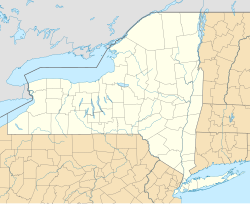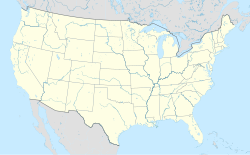Cradle of Aviation Museum
 | |
| Location | Uniondale, New York |
|---|---|
| Type | Aviation museum |
| Founder | George C. Dade |
| Curator | Joshua Stoff |
| Public transit access | LIRR stations: Garden City, Mineola, Westbury |
| Website | www |
40°43′43″N 73°35′51″W / 40.7286°N 73.5976°W
The Cradle of Aviation Museum is an aerospace museum located in Uniondale, New York on Long Island, established to commemorate Long Island's part in the history of aviation. It is located on land once part of Mitchel Air Force Base which, together with nearby Roosevelt Field and other airfields on the Hempstead Plains, was the site of many historic flights. So many seminal flights had occurred in the area that, by the mid-1920s, the cluster of airfields was already dubbed the "Cradle of Aviation",[1] the origin of the museum's name.
Naming rights to the museum are held by Flagstar Bank.[2]
Long Island – The Cradle of Aviation
[edit]Aviation firsts that contributed to Long Island's nickname – the "Cradle of Aviation":[3]
- 1873 – First recorded flight over the island, a balloon piloted by W. H. Donaldson from Brooklyn to Queens Village.
- 1874 – More balloon flights, New York City to Lynbrook and Lynbrook to Hempstead.
- 1909 – Glenn Curtiss flies a plane 25 miles from Mineola and wins the Scientific American Prize.
- 1910 – The International Aerial Tournament is held at Belmont Park.
- 1911 – Cal Rodgers makes the first transcontinental airplane flight from Sheepshead Bay to California in the Vin Fiz Flyer.
- 1916 – First night flight. [citation needed]
- 1917 – First flight of pilotless aircraft, the Sperry Aerial Torpedo.
- 1919 – First transatlantic flight by any aircraft, via airplane (US Navy NC-4 (flying boat)) from NAS Rockaway, Long Island, and arrived at Plymouth England, via stops in Massachusetts, Newfoundland, the Azores, and Portugal.[4]
- 1919 – First transatlantic crossing by an airship (R34 (airship)) which arrives at Roosevelt Field from England.
- 1923 – First non-stop transcontinental airplane flight from Mitchel Field to San Diego, CA by John A. Macready and Oakley G. Kelly.
- 1924 – First round-the-world flight arrives at Mitchel Field.
- 1927 – First solo transatlantic flight by Charles Lindbergh from Roosevelt Field to Paris, France.
- 1927 – First transatlantic passenger flight by Clarence D. Chamberlin from Roosevelt Field to Eisleben, Germany.
- 1929 – First "blind" instrument flight by Jimmy Doolittle at Mitchel Field. Instruments developed by the Sperry and Kollsman companies of Long Island.
The Cradle of Aviation Museum's first curator, William K. Kaiser, participated in an aviation first as one of the pilots on the first transatlantic crossing of non-rigid airships in 1944 as a young ensign in the United States Navy.[5][6] For his educational contributions and curatorial work at the Cradle of Aviation Museum, Kaiser was named a Jimmy Doolittle Fellow and an Ira Eaker Fellow by the Air Force Association Aerospace Education Foundation in 1986.[7]
Museum origins
[edit]The first Cradle of Aviation Museum Newsletters were published periodically by the Friends of Nassau County Museum when the air museum itself was still just a dream of Kaiser and George C. Dade, the museum's first director. Along with Henry Anholzer of Pan American Airlines and a team of volunteers, they acquired and restored numerous aircraft. These aircraft reflected some of Long Island's aviation firsts and its local aerospace industry. The first acquisition was a World War I Curtiss JN-4D discovered in an Iowa pig barn by Dade in 1973. Apparently, Lindbergh later confirmed that this was his very first airplane.[8] According to their Spring 1979 newsletter, the museum also had a Ryan Brougham (sister ship of the Spirit of St. Louis), Republic P-47N Thunderbolt, Republic Seabee, Grumman F-11A Tiger, and a Grumman Lunar Module spacecraft.[9] These aircraft were destined to occupy hangars 3 and 4 of Mitchel Air Force Base which was acquired by Nassau County when the base closed in 1961. The museum originally opened with just a handful of aircraft in the un-restored hangars in 1980. A major renovation and expansion program in the late 1990s allowed the museum to re-open in a state-of-the-art facility in 2002.
Aircraft
[edit]Today the museum contains over 70 aircraft and scale models of airplanes from various time periods, including Charles Lindbergh's Curtiss Jenny in which he barnstormed, the A-10 Thunderbolt II and Grumman F-14 Tomcat and an unused Apollo Lunar Module, LM-13.[10] LM-13 was scheduled to land on the Moon with the Apollo 19 mission, but the mission was cancelled and it remained on Earth, close to its birthplace in the Grumman Aircraft Engineering Corporation facility in nearby Bethpage, New York.[11]

Many of the tour guides and restoration workers formerly worked at Grumman, which contributed much to the museum.[12] The museum consists of eight chronological galleries with an approximately equal number of aircraft in each gallery. It is one of the only museums in the United States to cover all aspects of aviation/space history including pioneer aircraft, Golden Age aircraft, warbirds, civil, general, commercial and jet aircraft as well as spacecraft
The museum is one of the more popular Air and Space museums in the United States and has installations that include audio-visual, and unique hands-on and interactive exhibits, including a 'cockpit trail' where visitors can sit in an aircraft cockpit from each era. The museum's longtime curator (1985–present), Joshua Stoff, is a respected aerospace author and active member of the aviation museum community.[13]
In addition to the museum itself, the complex houses the JET BLUE DOME theater featuring digital format films as well as a digital planetarium, and an onsite cafeteria/catering venue
Firefighter Museum
[edit]Within the same building, the Cradle of Aviation Museum houses the Nassau County Firefighter's Museum and Education Center. It is a nearly 10,000 square foot interactive facility. Visitors can also trace the history of firefighting in Nassau County with hands-on exhibits that feature antique and contemporary fire apparatus and gear.
Gallery
[edit]-
Curtiss Golden Flyer replica
-
Grumman F3F-2
-
Folded wing of Grumman F6F Hellcat
-
Charles Lindbergh's flight gear
See also
[edit]- List of aerospace museums
- Statue of Sally Ride, which stands outside of the museum
References
[edit]- ^ Basset, Preston, "The History of Aviation on Long Island", Sperry Rand Corporation, 1957.
- ^ Schachter, Ken (28 April 2021). "New York Community Bancorp to acquire Michigan's Flagstar Bancorp in $2.6 billion stock deal". Newsday. Retrieved 14 July 2024.
- ^ Kaiser, William K., Ed., The development of the aerospace industry on Long Island, 3 vols., Hofstra University, Hempstead, N.Y., 1968, LC Control No: 67030029.
- ^ "80-G-415501 NC-4 Trans-Atlantic flight, 1919".
- ^ "Blimp Squadron ZP-14". Archived from the original on 2009-11-13. Retrieved 2009-12-16.
- ^ "Archived copy" (PDF). Archived from the original (PDF) on 2015-02-17. Retrieved 2013-06-19.
{{cite web}}: CS1 maint: archived copy as title (link) - ^ "Home - Air Force Association". Retrieved 27 November 2016.
- ^ Thomas, Robert McG. Jr. (May 29, 1998). "George C. Dade Dies at 85; Fliers Inspired His Museum". The New York Times. Retrieved 2011-11-25.
- ^ Cradle of Aviation Museum Newsletter, Spring 1979, Friends of the Nassau County Museum, Syosset, NY
- ^ LM-13 is one of the American Society of Mechanical Engineers "Landmark" projects - http://www.asme.org/Communities/History/Landmarks/Apollo_Lunar_Module_LM13_1972.cfm, retrieved 2008-05-21
- ^ "Grumman Lunar Module LM-13 - the Cradle of Aviation Museum". Archived from the original on 2012-02-04. Retrieved 2011-12-18.
- ^ Grumman changed its name to Grumman Aerospace Corporation in 1969, and was sold to Northrop in 1994, after which the company's Long Island facilities were closed down.
- ^ "Optimum Community". Archived from the original on 17 February 2012. Retrieved 27 November 2016.



